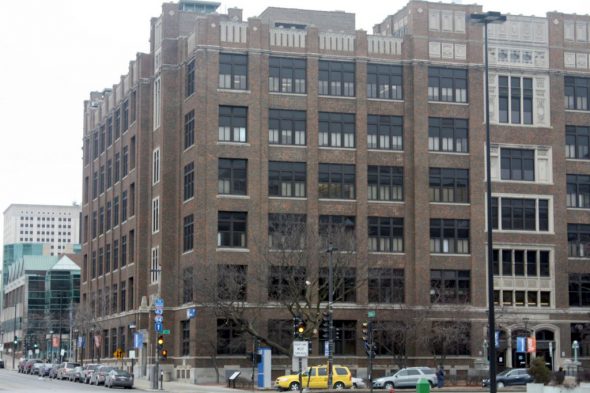Federal CARES Act Shows Racial Bias
Nearly twice as much funding for mostly white UW-Madison students than for mostly minority MATC students.
![Bascom Hall on the University of Wisconsin campus. Photo by Rosina Peixoto (Own work) [CC BY-SA 3.0 (http://creativecommons.org/licenses/by-sa/3.0)], via Wikimedia Commons](https://urbanmilwaukee.com/wp-content/uploads/2016/12/Bascom_Hall_in_Madison.jpg)
Bascom Hall on the University of Wisconsin campus. Photo by Rosina Peixoto (Own work) (CC BY-SA 3.0), via Wikimedia Commons
We need look no further than the way the Coronavirus Aid, Relief, and Economic Security Act (CARES) was directed at higher education funding in Wisconsin to see a perfect illustration of systemic racism: unequal treatment that is baked into public policy.
Let’s look at the disparity between the treatment of two absolutely crucial institutions, UW Madison and Milwaukee Area Technical College (MATC) by the CARES Act and how this disparity affects students of different races and classes.
UW Madison received almost $20 million or $437 per student, while MATC received only $8.6 million or $249 per student. Are MATC students 43% less needy or worthy than Madison students? Hardly. Median family income of UW Madison students is $95,000 annually while for MATC students it’s barely half that at $51,000, almost $10,000 less than Wisconsin’s median family income.
And as important as our flagship university is, MATC students are pursuing education that prepares them to be the nation’s essential workers: nurses, respiratory therapists, firefighters, EMTs, police officers and more.
While MATC students have more unmet needs, they’re also less white than those at UW-Madison. Only 7% of UW Madison’s 45,319 students are African American, Native Americans or Latinx. MATC, on the other hand, is the state’s only majority minority college.
How could a bill intended to help those in need end up helping the privileged much more, and actually discriminate against students of color? The answer is found in a metric used by both state and federal government to distribute aid to higher education — Full Time Equivalents (FTE). This measurement treats a full-time student as normal. However, students from low-income families need to work to afford college and generally cannot survive full class loads. The majority of college students, slightly more than 50%, attend part-time. Part-time students are older, are disproportionately from minority/ethnic backgrounds and more likely to be the first in their family to attend college.
Take Shemicka Free, a recent Respiratory Therapist graduate who worked two jobs while taking care of her children and attending MATC. She took part time classes for several semesters before she could go full time. However, Shemicka’s rent, food, clothing and utility bills weren’t on a sliding scale based on the number of credits she took. Her needs were great when she was a part-time student, and even greater than the average student taking a full course load at UW-Madison.
This uneven dynamic exists throughout the country. The Georgetown University Center on Poverty and Inequality focused a study on older students who commonly attend part-time. Their analysis shows that average annual overall costs beyond tuition are statistically higher for part-time students ($43,040) compared to full-time students ($38,237).
The good news is that this is an easy problem to fix.
Organizations like The Hope Center for College, Community and Justice at Temple University recommend junking the current FTE system as the benchmark measure to base student aid on, and using a much simpler method. “Both federal and state policymakers should revise their institutional funding formulae to emphasize headcount rather than FTE’s.”
FTEs may not have been intended to perpetuate and exacerbate racism, but that’s irrelevant. They do. Replacing aid formulas from FTE to head count would help reverse this systemic discrimination. It would greatly help community colleges like MATC that educate almost 40% of the nation’s students, and a much higher percentage of non-white students than four-year colleges.
Every student requires support from their college and for their living expenses, regardless of how many credits they take each semester. Part time students’ educations should not be discounted as if they are less important. The HOPE Center recommends that,” Both federal and state policymakers should revise their institutional funding formulae to emphasize headcount rather than FTE. Doing so will promote equity and direct the flow of public funding towards the most public of all higher education institutions: the community colleges.”
If our goal is to create an educated populous and thriving multiracial democracy, we must invest in our students of color, and the comprehensive two-year colleges like MATC that they attend.
One concrete way of making black lives matter would be to remove the current ingredient from the college aid formula that carries the systemic virus of racism.
If you think stories like this are important, become a member of Urban Milwaukee and help support real, independent journalism. Plus you get some cool added benefits.
Op-Ed
-
Unlocking Milwaukee’s Potential Through Smart Zoning Reform
 Jul 5th, 2024 by Ariam Kesete
Jul 5th, 2024 by Ariam Kesete
-
We Energies’ Natural Gas Plans Are A Mistake
 Jun 28th, 2024 by John Imes
Jun 28th, 2024 by John Imes
-
Milwaukee Needs New Kind of School Board
 Jun 26th, 2024 by Jordan Morales
Jun 26th, 2024 by Jordan Morales





















